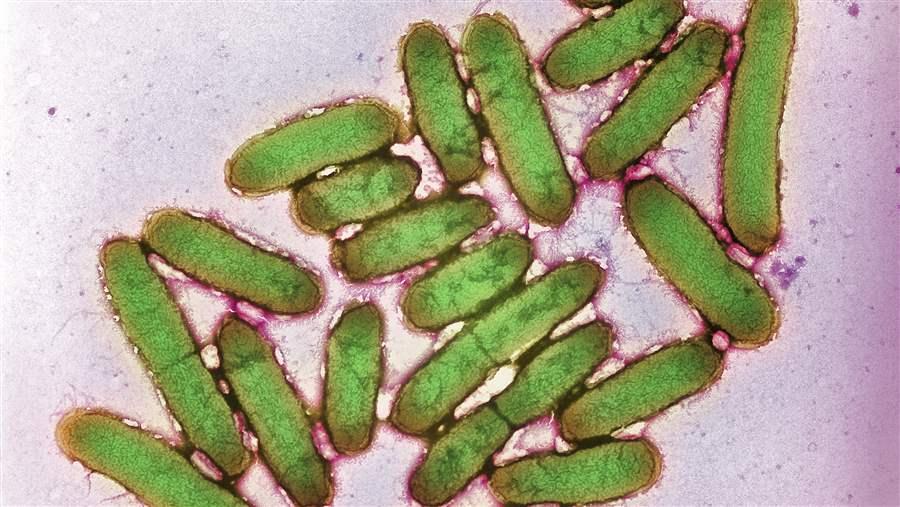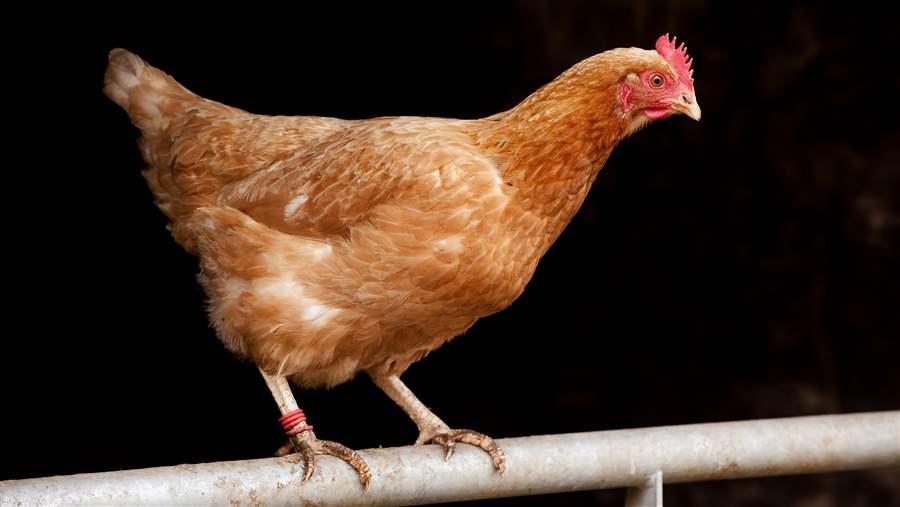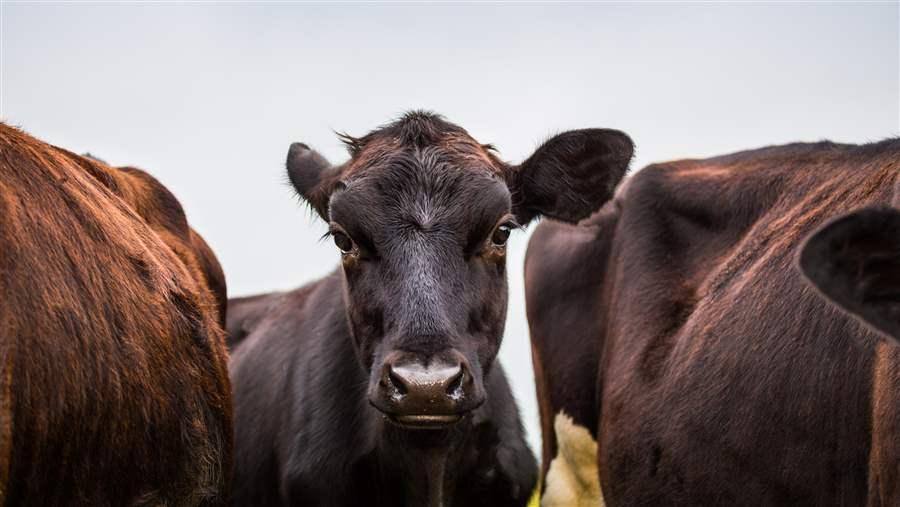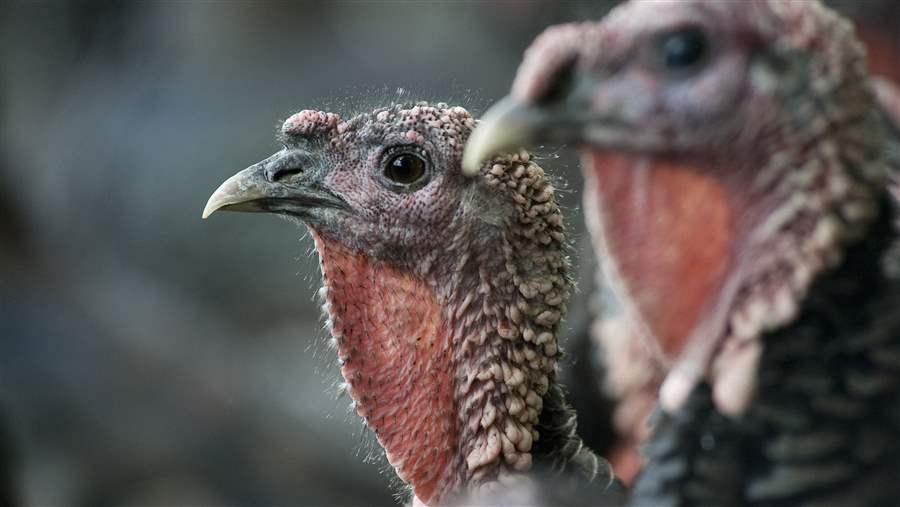Antibiotic Use in Food Animals Poses Risk to Public Health
More research needed, but studies show clear link between antibiotic resistance emerging on farms and drug-resistant infections in people

The molecular processes by which antibiotic resistance emerges, spreads, and potentially disappears in bacteria, such as these E. coli cells viewed under a microscope, are complex.
A. Barry Dowsett/Science SourceOverview
The use of antibiotics in any setting contributes to the emergence of drug-resistant bacteria, and the administration of antibiotics to food animals is no exception. While the path from antibiotic use in animal agriculture to the subsequent public health risk posed by resistant bacteria is a complex one—involving multiple steps and transmission routes—and is influenced by various external factors, the connection is irrefutable. While there is insufficient data to quantify the public health burden associated with antibiotic use in animal agriculture and how it compares with other sources, such as in human medicine, there is no doubt that antibiotic use on farms or feedlots contributes to the problem of resistance and leads to worse public health outcomes than if the bacteria were not resistant. It is therefore important to take immediate action to ensure that antibiotics are used judiciously and only when needed.
Why the Emergence and Spread of Antibiotic Resistance Is Complicated
The molecular processes by which antibiotic resistance emerges, spreads, and potentially disappears are complex. Some resistance genes occur naturally in the environment, fully independent of exposure to antibiotics. In fact, scientists have identified genes with resistance properties that date back millions of years,1 long before humans discovered antibiotics at the beginning of the 20th century.
Additionally, not every antibiotic works against every type of bacterium; some bacteria are inherently unaffected by certain drugs. For instance, an antibiotic may be effective only in killing bacteria with a certain type of molecular structure, leaving bacteria without that particular structure unaffected.
Bacteria can acquire antibiotic resistance through a number of mechanisms. Sometimes they develop it gradually through multiple sequential genetic changes over time. How quickly this process occurs depends on a number of factors, including the type of bacterium, the negative effect (i.e., “fitness cost”) the changes have on the bacterium, and the nature of the antibiotic exposure. However, bacteria can also quickly develop resistance when they share their resistance genes. Additionally, bacteria can share a number of genes at the same time, including those that confer traits unrelated to antibiotic resistance, which can complicate the dynamics of antibiotic resistance through a process called co-selection.
In co-selection, resistance genes are physically linked to genes carrying other traits, such as lower susceptibility to otherwise toxic concentrations of heavy metals. The process can cause bacteria no longer exposed to antibiotics to retain their antibiotic resistance properties, which would otherwise be disadvantageous.
For the above reasons, resistance may appear or disappear significantly faster in some situations than in others, and perhaps not at all during a period of study. As demonstrated by the study examples below, research conducted in various settings, with different antibiotics or types of bacteria being analyzed, may yield disparate results. This makes studying the ecology of antibiotic use and the emergence of resistance complicated.
Sources of evidence
Researchers have conducted numerous studies relevant to antibiotic use in animal agriculture and its link to public health. When analyzing the data, it is important to bear in mind that levels of confidence associated with study results vary by their design. Randomized controlled trials typically offer the highest quality of evidence2 but are not always feasible or ethical. Epidemiological studies also provide high-quality evidence, with other types of studies—such as case reports or outbreak investigations—informative as well. Rather than focusing on an individual study, each should be considered in context within the larger body of evidence and in light of the strengths and weaknesses of the specific study type.
Below is a high-level overview of the scientific data available to address three key questions. For a more comprehensive analysis of this data, see Pew’s peer-reviewed publication on the link between antimicrobial drug use on farms and associated human health risks.3 A more comprehensive list of relevant studies can be found in the associated downloadable tables, which include data from various types of studies, bacteria, and animal species.
1. Does using antibiotics on farms and feedlots lead to the emergence of resistant bacteria?
Yes. Studies on two types of bacteria on farms or feedlots are relevant to this question. Pathogens such as Salmonella or Campylobacter, which can cause disease in humans, and commensal bacteria, “friendly” microorganisms that occur naturally in the environment, which are harmless in isolation but can ultimately share their resistance genes with bacteria that can make people sick. Evidence from both types of bacteria has demonstrated that antibiotic use causes resistance.
- Emergence of resistance in pathogens. Numerous studies, including a variety of randomized control studies in which some animals are given antibiotics under tightly controlled experimental conditions while others are not, and in which bacteria from the exposed and unexposed animals are compared, show that resistant bacteria can and do emerge after food animals were exposed to antibiotics, even though resistance did not emerge during the study period in all cases. Evidence from observational studies and other types of studies have generally yielded similar results. In some cases animals were infected experimentally, and in others the bacteria were naturally present.
For example, in one randomized control trial, broiler chickens were infected with strains of Campylobacter known not to be resistant to fluoroquinolone antibiotics, and days later chickens in the experimental group were given the antibiotics, whereas the control group was not. Fluoroquinolone resistance emerged rapidly in the Campylobacter collected from exposed birds but not in the nontreated control birds.4 Another trial evaluated the impact of a single exposure of naturally occurring Campylobacter populations, which had been isolated from pigs, to the antibiotic enrofloxacin.5 No resistance was detected prior to the study, but after exposure, bacteria with high resistance to two related antibiotics (nalidixic acid and ciprofloxacin) were detected up to 35 days after exposure.
- Emergence of resistance in commensals. Because these “friendly” bacteria tend to be easier to study than pathogens, much more research has been done on them and has shown that on-farm antibiotic use can and does lead to an increase in resistance among commensals, which can then transfer to more harmful bacteria. Notably, some research simultaneously studying the emergence of resistance in pathogens and commensals found that resistance emerged more rapidly in commensals, which may make them better indicators of resistance.
In one study, feedlot cattle were given antibiotics in feed for more than a month, followed by almost three months of feed without antibiotics. They were then given antibiotics for another 42 days through a different type of feed.6 Exposure to antibiotics significantly increased the prevalence of resistant bacteria. Furthermore, the type of feed had an important impact on how quickly these resistant strains of bacteria disappeared.
2. Are resistant bacteria on farms or feedlots infecting people?
Yes. Resistant bacteria—both pathogens and commensals—pose a risk to humans both directly and indirectly.
- Direct risk: Transmission of resistant pathogens to humans. While randomized controlled trials— which would require intentionally exposing people to resistant pathogens—would be unethical, observational studies, as well as other types of research, such as outbreak investigations, case reports, and epidemiologic studies, confirm that foodborne and zoonotic pathogens can be and are transmitted from animals to people, and cause infections. The routes of transmission are complex and multifaceted but have three primary pathways: direct contact with infected animals, foodborne illness, and environmental transmission. Currently, there is no way to quantify which transmission route is most significant, though food is likely one common source.7
For example, a case control study in California compared healthy subjects with patients sick from strains of Salmonella Newport bacteria known to be resistant to the antibiotic chloramphenicol.8 Compared with healthy subjects, the people infected with resistant S. Newport were significantly more likely to have eaten ground beef during the week before the onset of illness and to have used penicillin and tetracycline in the month prior to symptoms. In Denmark, another outbreak of infections with a rare strain of multidrug-resistant Salmonella Typhimurium bacteria in human patients was traced back to pork samples that originated from a specific swine herd.9 Notably, the patients were more difficult to treat because of the bacteria’s resistance to antibiotics. - Indirect risk: Transmission of resistance genes to bacteria that make people sick. A variety of randomized controlled trials and observational studies have demonstrated that commensal bacteria from animals can temporarily establish themselves in humans—for instance, when people have contact with the animals that originally carried the bacteria or handle their meat. Strong scientific evidence further shows that these commensals can and do share their resistance genes with human commensals and pathogens. Notably, the presence of antibiotics seems to make such exchanges of resistance genes more likely, but it can happen without them as well.
In one cohort study in the U.S., broiler chickens were given the antibiotic tetracycline in their feed, and investigators studied its effects on the intestinal bacteria of a farm family who worked with the chickens and the family’s neighbors.10 The emergence of tetracycline resistance was traced in the commensal intestinal bacteria isolated from the birds and in commensal bacteria isolated from workers on the farm. Antibiotic resistance clearly emerged after use on the farm, and resistance was more common in the bacteria from exposed farm family members than from their neighbors.
3. Are infections with these resistant bacteria worse than if the bacteria were not resistant?
Yes. Strong scientific evidence, including observational studies and other types of research, demonstrate that infections with resistant bacteria are leading to worse health outcomes for affected people than similar infections with nonresistant strains. For the reasons discussed above, randomized controlled trials would be unethical, but the associated downloadable table synthesizes some of the relevant studies. Notably, the degree to which infections with resistant bacteria are worse than those with nonresistant strains appears to differ by pathogen and drug. These differences may, for instance, be the result of a delay in starting effective treatments or the need to choose a less desirable antibiotic if more desirable drugs have become ineffective, and, in some cases, resistant bacteria may “co-select” for other traits that make them more dangerous to humans—for example, more likely to invade the bloodstream.
A five-year cohort study in the U.S., for instance, compared the frequency of hospitalization and bloodstream infections in patients infected with strains of resistant Salmonella bacteria to those with strains that were not.11 The patients infected with resistant bacteria were more likely to suffer from bloodstream infections and also more likely to be hospitalized because of them. Furthermore, of all the patients who ended up hospitalized, those infected with resistant bacteria had longer stays than those with susceptible infections.
Conclusion
Taken together, the scientific findings show an indisputable relationship between antibiotic use on farms and drug-resistant infections in people. Not all bacteria or even bacterial strains react alike in the presence of antibiotics, and external factors can affect the rate at which resistance emerges or disappears. In spite of the gaps in information, it is irrefutable that antibiotic use in animal agriculture contributes to the problem of resistance, and increased vigilance is needed to protect these lifesaving drugs so that they remain available to treat infections in both humans and animals.
A more comprehensive list of relevant studies can be found in the downloadable tables associated with this issue brief. These tables include data from various types of studies, bacteria, and animal species and can also be found under “Related Resources” (linked above).
Endnotes
- Andrew C. Pawlowski et al., “A Diverse Intrinsic Antibiotic Resistome From a Cave Bacterium,” Nature Communications 7 (2016): 13803, https://www.nature.com/articles/ncomms13803.
- David Atkins et al., “Grading Quality of Evidence and Strength of Recommendations,” BMJ (Clinical Research Edition) 328, no. 7454 (2004): 1490, https://www.ncbi.nlm.nih.gov/pmc/articles/PMC428525.
- Karin Hoelzer et al., “Antimicrobial Drug Use in Food-Producing Animals and Associated Human Health Risks: What, and How Strong, Is the Evidence?” BMC Veterinary Research 13, no. 1 (2017): 211, https://link.springer.com/epdf/10.1186/s12917-017-1131-3?author_access_token=CbmecKjS4XscxgMn92-6rm_BpE1tBhCbnbw3BuzI2RMGFJmV0iy8Y06YFc2zc-R5jN1X3crDybEToB_ CzXCpRozpkwGnxg9ydolzETVy02VGkppjTRq1V0MGiTqrqtB8g2U114wU4Fb9RacL AHWYIA==.
- Patrick F. McDermott et al., “Ciprofloxacin Resistance in Campylobacter jejuni Evolves Rapidly in Chickens Treated With Fluoroquinolones,” The Journal of Infectious Diseases 185, no. 6 (2002): 837–40, https://academic.oup.com/jid/article/185/6/837/879676. See study 46 in Table 1 in the associated downloadable table.
- Anne A. Delsol et al., “Emergence of Fluoroquinolone Resistance in the Native Campylobacter coli Population of Pigs Exposed to Enrofloxacin,” Journal of Antimicrobial Chemotherapy 53, no. 5 (2004): 872–74, https://academic.oup.com/jac/article/53/5/872/747045. See study 52 in Table 1 in the associated downloadable table.
- T.W. Alexander et al., “Effect of Subtherapeutic Administration of Antibiotics on the Prevalence of Antibiotic-Resistant Escherichia coli Bacteria in Feedlot Cattle,” Applied and Environmental Microbiology 74, no. 14 (2008): 4405–16, http://aem.asm.org/content/74/14/4405. full. See study 65 in Table 2 in the associated downloadable table.
- B.A. Wall et al., “Drivers, Dynamics, and Epidemiology of Antimicrobial Resistance in Animal Production” (2016), http://www.fao.org/documents/card/en/c/d5f6d40d-ef08-4fcc-866b-5e5a92a12dbf.
- John S. Spika et al., “Chloramphenicol-Resistant Salmonella Newport Traced Through Hamburger to Dairy Farms,” New England Journal of Medicine 316, no. 10 (1987): 565–70, http://www.nejm.org/doi/full/10.1056/NEJM198703053161001. See study 90 in Table 3 in the associated downloadable table.
- Kåre Mølbak et al., “An Outbreak of Multidrug-Resistant, Quinolone-Resistant Salmonella enterica Serotype Typhimurium DT104,” New England Journal of Medicine 341, no. 19 (1999): 1420–25, http://www.nejm.org/doi/pdf/10.1056/NEJM199911043411902. See study 94 in Table 3 in the associated downloadable table.
- Stuart B. Levy, George B. FitzGerald, and Ann B. Macone, “Changes in Intestinal Flora of Farm Personnel After Introduction of a Tetracycline-Supplemented Feed on a Farm,” New England Journal of Medicine 295, no. 11 (1976): 583–88, http://www.nejm.org/doi/pdf/10.1056/NEJM197609092951103. See study 102 in Table 4 in the associated downloadable table.
- Jay K. Varma et al., “Antimicrobial-Resistant Nontyphoidal Salmonella Is Associated With Excess Bloodstream Infections and Hospitalizations,” The Journal of Infectious Diseases 191, no. 4 (2005): 554–61, https://academic.oup.com/jid/article/191/4/554/938107/Antimicrobial-Resistant-Nontyphoidal-Salmonella-Is. See study 121 in Table 5 in the associated downloadable table.


Link Reaffirmed Between Antibiotic Use in Animal Agriculture and the Public Health Risk
An analysis of the strength of the scientific evidence and remaining data gaps


Antibiotics and Animal Agriculture: A Primer
Why are antibiotics used in animal agriculture, and what can be done to ensure their appropriate use?










